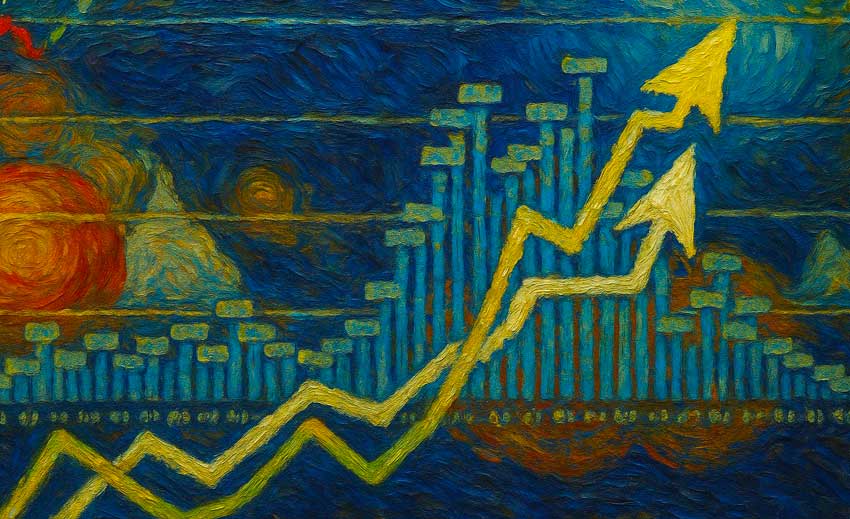I problemi economici si manifestano sempre con caratteri diversi, il che da un lato rappresenta il fascino della materia, dall’altro corre il rischio di far fare una pessima figura agli economisti.
Tra le numerose contraddizioni che caratterizzano la nostra economia, questi primi nove mesi del 2025 ce ne consegnano un’altra. Dall’inizio dell’anno la borsa italiana ha realizzato una performance eccellente: il FTSE MIB è cresciuto di circa il 25 %, uno dei migliori risultati in Europa.
Il rialzo italiano è trainato da aspettative di tagli ai tassi da parte della BCE, dall’afflusso di capitali esteri in fuga dal dollaro, dai grandi utili delle principali banche e… da cos’altro?
Qui iniziano le complicazioni. Se spostiamo lo sguardo sull’economia reale, il quadro è davvero poco brillante. Il Pil 2025 italiano è stimato allo +0,6%, (più o meno come lo scorso anno) a conferma della persistente stagnazione; una crescita modesta, poco conciliabile con il risultato borsistico. Per non parlare dei salari, ancora sotto i livelli reali del 2021.
Anche negli Usa c’è una divergenza tra l’economia reale e il mercato borsistico, ma decisamente meno accentuata. Oltre oceano, a fronte di un Pil stimato per il 2025 in crescita circa del 1,6%, l’indice di borsa Dow Jones registra ad oggi un +9 % ed il Nasdaq 100 un +17,5 %.
A complicare ulteriormente il quadro italiano, si aggiunga che nel 2025, il numero e la dimensione delle società quotate, invece di crescere, trainati dalle ottime performance, continuano a diminuire. Anche se il trend dura (purtroppo) da anni, il contrasto con i dati di questi primi nove mesi è particolarmente evidente.
Né le performance del listino trovano giustificazioni dai cd “valori fondamentali” delle società quotate. Scrive Bankitalia nel suo Rapporto sulla stabilità finanziaria di Aprile 2025: “Nel 2024 il margine operativo lordo (MOL) si è ridotto del 5,1 per cento… per quest’anno le più recenti previsioni degli analisti sugli utili delle società quotate indicano una flessione rispetto al 2024”.
La divergenza tra la performance del listino e l’economia reale è una anomalia da indagare nell’interesse dello sviluppo e della stabilità finanziaria del Paese.
* Economista
Economic problems always manifest themselves in different ways, which on the one hand is the fascination of the subject, but on the other hand runs the risk of making economists look bad.
Among the many contradictions characterizing our economy, these first nine months of 2025 have brought us another. Since the beginning of the year, the Italian stock market has achieved an excellent performance: the FTSE MIB has risen by approximately 25%, one of the best results in Europe.
The Italian rally is driven by expectations of rate cuts by the ECB, the influx of foreign capital fleeing the dollar, the large profits of major banks, and… what else?
Here’s where the complications begin. If we shift our gaze to the real economy, the picture is truly bleak. Italian GDP in 2025 is estimated at +0.6% (about the same as last year), confirming the ongoing stagnation; modest growth, hardly reconcilable with the stock market performance. Not to mention wages, still below 2021 real levels.
In the US, too, there is a divergence between the real economy and the stock market, but much less pronounced. Across the pond, with GDP estimated to grow by approximately 1.6% in 2025, the Dow Jones stock market index is currently up 9% and the Nasdaq 100 is up 17.5%.
Further complicating the Italian picture is the fact that in 2025, the number and size of listed companies, rather than growing, driven by excellent performance, will continue to decline. Although this trend has (unfortunately) persisted for years, the contrast with the data from these first nine months is particularly stark.
Nor are the stock market’s performances justified by the so-called “fundamental values” of listed companies. The Bank of Italy writes in its April 2025 Financial Stability Report: ” In 2024, gross operating profit (EBITDA) fell by 5.1 percent… for this year, analysts’ most recent forecasts for listed companies’ earnings indicate a decline compared to 2024.”
The divergence between stock market performance and the real economy is an anomaly that must be investigated in the interests of the country’s development and financial stability.
* Economist


